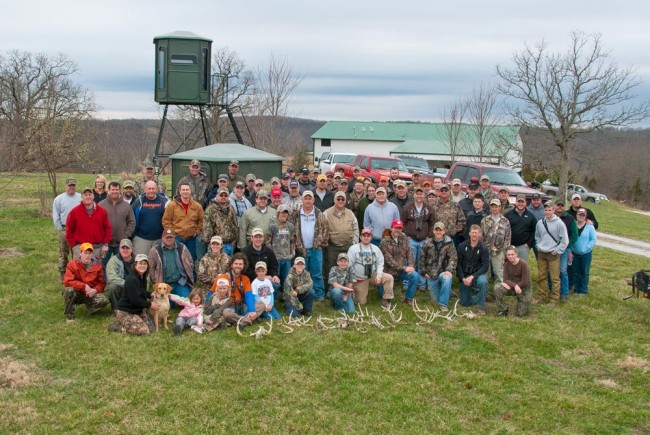Category: White-tailed Deer
Shed Hunt 2011
I really enjoyed the 2nd Annual Shed Hunt! There were fellow deer hunters from 14 states that attended. There were hunting buddies, husband and wives, and families. They came from Texas, Michigan, Indiana, and most states in between. They came from different hunting cultures, different occupations, and hunting experiences. However, they were all deer hunters!! We all laughed and learned together. It was a great event that left me with new friends and ideas.
As I reflect on the great conversations I had this weekend, I’m so saddened when hearing about hunters arguing with each other. White-tailed deer have been extremely abundant throughout most of their range for many years. However, this trend is changing. Several states are now reporting reduced harvest rates. There are several reasons including loss of habitat, loss of hunters, and increased predation. During this era of change in hunters and hunting, it is critical that we deer hunters/managers pull together. We need to identify projects we can unite around and fight for the continued success of white-tailed deer and deer hunters. Silly arguments like whether crossbows should be legal are useless if there are limited deer populations and no deer seasons.
Please remember as deer hunters we have a joint mission of producing healthy herds and providing safe and enjoyable hunting opportunities. Our mission is tough, and may become tougher. There is no room for arguing among our ranks. Our energy is much better spent helping each other.
I believe the best method to stop the arguing is through education. That’s one reason I so enjoy our Shed Hunt and Food Plot Field Day events. It’s a great time for hunters from different cultures to come together on neutral ground and see new techniques and share their knowledge. I really appreciate all the Shed Hunt 2011 attendees that joined my family and me. I hope we shared some useful information with them. I look forward to joining ranks and fighting for our deer herds and for each other. Deer hunters are a family. Good families work to make each member the best they can be.
Growing Deer (and deer hunters) together,
Grant
Late Winter Stress
I’m driving across Kansas today through heavy falling snow. The temperature is thirty degrees and it will get colder tonight. These types of late winter storms cause wildlife, including deer, great stress. Kansas is able to produce mature bucks that express a lot of their antler growth potential year after year despite these harsh conditions. This is mostly because of the large amount of corn and soybeans grown here. Even though I haven’t seen any standing grain there are huge expanses of non-tilled corn and soybean fields that provide enough quality food to allow deer to survive through the winter with reduced stress. These same weather conditions in nonagricultural areas would likely result in hungry deer that don’t have access to a quality food source to alleviate the stress.
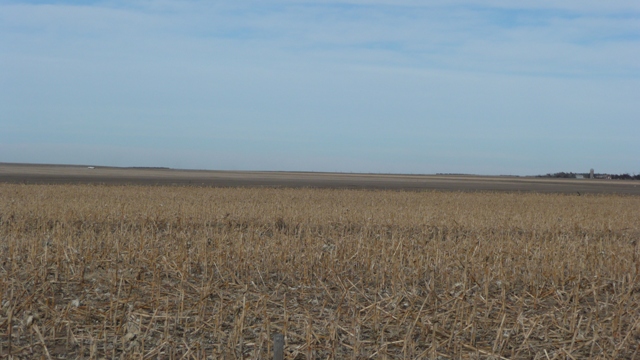 It requires a huge amount of acreage in harvested crops to provide enough grain to carry the deer herd because harvest techniques and modern combines are so efficient that little grain is spilled. The same quality of deer can be produced in nonagricultural areas with much smaller fields of grain if they are not harvested. One acre of grain left standing is probably equal to one hundred or more acres of harvested grain this time of year.
It requires a huge amount of acreage in harvested crops to provide enough grain to carry the deer herd because harvest techniques and modern combines are so efficient that little grain is spilled. The same quality of deer can be produced in nonagricultural areas with much smaller fields of grain if they are not harvested. One acre of grain left standing is probably equal to one hundred or more acres of harvested grain this time of year.
The limiting factor in most of western Kansas is cover. The limiting factor in much of the nonagricultural areas is food. By identifying the limiting factor and providing it in both areas deer managers allow the herd to express most of its potential. Late winter is a great time to take a drive across your property and identify the limiting factor.
Growing Deer together,
Grant
Monitor a Herd’s Health by Shed Hunting
Monitoring a deer herd’s health is a critical part of deer management. One of the most enjoyable methods to get an indication of a herd’s health is by going shed hunting! Bucks that hold their antlers through January in most of the whitetails’ range are usually healthy. However, bucks that shed before mid January are usually stressed, injured, or have a disease.
Earlier this week Tracy (my wife) and her shed hunting lab (Crystal) searched several food plots for sheds. The next day Brad drove by one of those plots and saw the right antler from Hidden Valley 8 in plain view. It is very doubtful Tracy and Crystal would have missed that large (62”) shed. That gave me an exact date of when Hidden Valley 8 shed his right side. That’s obviously a rare event to know exactly when a free-ranging buck sheds.
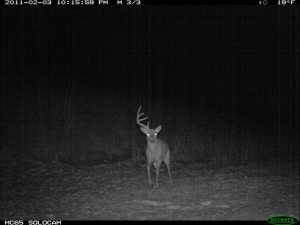 However, much data about when bucks shed can be easily collected by using trail cameras. The average date bucks of each age class shed can easily be calculated. Discovering that an individual buck shed early is not a reason for major concern. However, if a majority of the bucks have shed before January, the herd is experiencing significantly stress, probably due to malnutrition. If most of the bucks still have their antlers through most of January, the herd is probably in good health.
However, much data about when bucks shed can be easily collected by using trail cameras. The average date bucks of each age class shed can easily be calculated. Discovering that an individual buck shed early is not a reason for major concern. However, if a majority of the bucks have shed before January, the herd is experiencing significantly stress, probably due to malnutrition. If most of the bucks still have their antlers through most of January, the herd is probably in good health.
Images of an individual mature buck that shed early are often an indication he has been injured. Closer inspection of the trail camera images may allow determination of the location and extent of the injury.
It is fun to hunt an individual deer, but management of free-ranging herds is best when the entire population is considered. Evidence that a mature buck is injured is disheartening. Evidence that the entire herd is experiencing substantial stress is very concerning and should result in action.
Go shed hunting this week and investigate the health of the local deer herd!
Growing Deer together,
Grant
Crunch Time
This is a great time of year for deer managers! There are usually some days with beautiful weather that makes us think about spring. It’s a great time to shed hunt as most of the mature bucks have dropped their antlers by now. We are collecting soil samples and ordering seed to prepare for the spring planting season! It truly is a fun time of year to be a deer manager.
However, it’s crunch time for mature bucks. Most mature bucks lose 30% + – of their body weight during the rut. Many of them didn’t have access to quality forage and/or grain to regain that weight. Due to the loss of weight, they’ve had a hard time staying warm. Most of the whitetails’ range has experienced wicked winter weather conditions with deep snow and below normal temperatures during the past month or more. These conditions not only made it tough to stay warm, but made accessing the limited food supply very difficult.
Added to these stresses predators are hungry also. With the ground frozen, they can’t find small rodents easily and often turn to larger prey. Many mature bucks received injuries during the rut and predators probably can detect the scent and or appearance of these injuries.
Given all these factors, it’s no surprise that the mortality rate of mature bucks during late winter can be extremely high. Good management can reduce the mortality rate of mature bucks during the late winter stress period through good habitat management. Making sure there is enough quality forage and grain and that its distribution is such that deer don’t have to travel far from cover to access quality food. Quality cover is another factor that helps mature bucks survive the winter. Thermal protection and areas that limit the effectiveness of predators are critical components of quality deer habitat. Again, cover should be distributed such that all deer don’t have to return to the same area for cover and therefore lead all predators to one location.
There will likely be more sheds to find next year if quality food and cover are provided for deer during crunch time this year.
Growing Deer together,
Grant
Pruning Fruit Trees
Hi Grant, I have been following your website for the past several months and truly enjoy receiving my latest edition from you each Monday. I am planting a dozen or so fruit trees. I know nothing about fruit trees other than I want to provide even more food for the deer and turkeys. The trees I have are about 6-7′ tall and are in 3 gallons. I am assuming they are probably 2-3 years old. Do you have any suggestions on pruning fruit trees? Thank you for what you are doing and may God continue to bless you richly. Kindest, Jason
Jason,
Thank you for the kind words and for watching GrowingDeer.tv! Different species of fruit trees require different pruning strategies. In general, most folks don’t seem to prune enough. However, I suggest you visit with the supplier where you purchased the fruit trees, or checkout some articles in Quality Whitetails or on the Quality Deer Management Association web site. They have published several articles that are specific to different species of fruit trees. Specifically I would recommend reading “A User’s Guide to Successful Apple Tree Plots.”
Growing Deer together,
Grant
Prescribed Fire
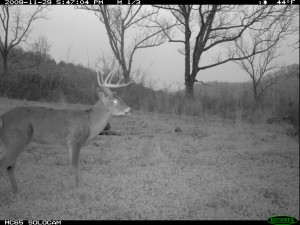
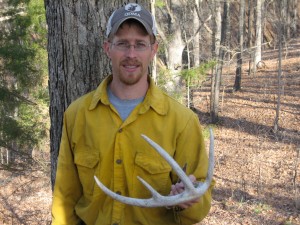
Yesterday Brad, Bill and I did a 120 acre prescribed fire. Towards the end of the day Brad found a shed from a buck we call Barely 10. He was tired from walking up and down the hill all day, but not too tired to carry out a nice shed.
Growing Deer together,
Grant



